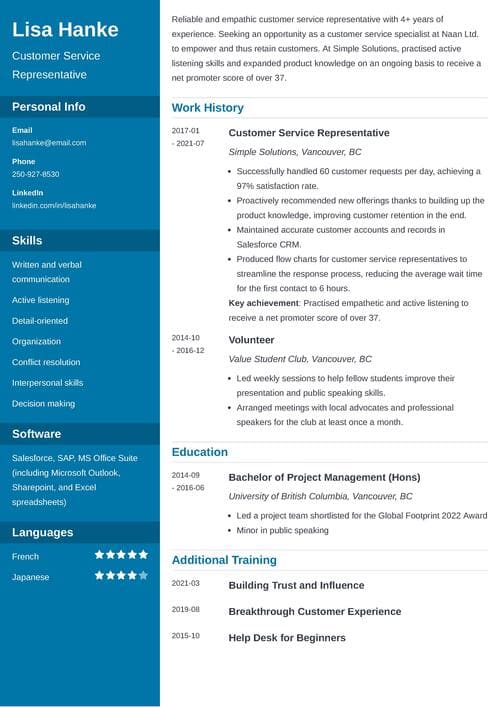


You’re not alone in thinking writing resumes is hard. But it does become less daunting when you learn how to make a resume with our guide. So what do you say?
If only writing a resume was so easy as falling off a log. Instead, it’s a balancing act between the relevant and interesting.
So how to make a resume that encompasses both? Give me 15 minutes to uplevel your game and know how to write a resume with relevant experience interesting enough to make your recruiter’s eyes pop.
You’ll learn:
Want to save time and have your resume ready in 5 minutes? Try our resume builder. It’s fast and easy to use. Plus, you’ll get ready-made content to add with one click. See 20+ resume templates and create your resume here.


Sample resume made in our builder—See more templates and create your resume here.
Want to jump right in and see some real-life examples? Go ahead and find the following resume guides:
Lisa Hanke
Customer Service Representative
250-927-8530
linkedin.com/in/lisahanke
Summary
Reliable and empathic customer service representative with 4+ years of experience. Seeking an opportunity as a customer service specialist at Naan Ltd. to empower and thus retain customers. At Simple Solutions, practised active listening skills and expanded product knowledge on an ongoing basis to receive a net promoter score of over 37.
Experience
Customer Service Representative
Simple Solutions, Vancouver, BC
January 2017–July 2021
Key achievement: Practised empathetic and active listening to receive a net promoter score of over 37.
Volunteer
Value Student Club, Vancouver, BC
October 2014–December 2016
Education
Bachelor of Project Management (Hons)
University of British Columbia, Vancouver, BC
2014–2016
Skills
Software Skills
Additional Training
Languages
Jump to chapters with this table of contents for how to write a resume:
Now—
Poor resume layout can be really bad for you. The i-am-not-going-to-read-your-resume type of bad. Recruiters sniff out laziness very quickly and don’t seem to love it.
Follow those basics to let them smell success early on:
ProTip: Don’t go overboard with your employment history. Hiring managers won’t have time to go through it all. Write about your experience over the last ten years. That way, you’ll avoid irrelevancy.
Because you can’t decide between maple or pancake syrup on pancakes, it doesn’t mean you have to have such a hard time choosing the correct resume format.
There are three:
And going one by one, the chronological resume format is the most common and widely used format by job applicants. The role of that format is to highlight your career progress by putting the experience section in the centre. Recruiters and ATS are familiar with it, so you can be sure it’s a safe bet.
The functional resume format focuses on your skillset, and it’s a better choice for career changers or jobs where the portfolio matters most. Beware, though, that recruiters aren’t fans of this format. It’s rare and makes it difficult to spot your professional achievements.
The last of the trinity is the hybrid of the two, rightly called the combination format. It’s the rarest and most complicated due to its extensive experience and skills sections. Therefore, use it only if you want to branch out or have a few gaps in your employment history.
For the sake of the article, I’ll go with the chronological format.
You’re done with the technicalities. Now you can start putting down words.
When making a resume in our builder, drag & drop bullet points, skills, and auto-fill the boring stuff. Spell check? Check. Start building a professional resume template here for free.
When you’re done, Zety’s resume builder will score your resume and tell you exactly how to make it better.
You should first write your contact details in your resume in the header. They should include:
Optionally, you can add your LinkedIn handle and your website address. It’s especially important to attach your electronic portfolio when applying for creative jobs.
But there are also things you should forever avoid in your resume, such as:
See below how a resume heading should look:
| RIGHT |
|---|
Lisa Hanke Customer Service Representative 250-927-8530 linkedin.com/in/lisahanke |
Even though it’s the shortest and easiest section in your resume, double-check your contact details. You don’t want the recruiter to call somebody else, eh?
Oh, and forget about an unprofessional name and domain in your email address. That’s off-putting and can cost you an interview.
Motivation comes and goes, but discipline will get you where you want to be.
And where your employer wants you to be.
Show they can count on you by stating clear objectives backed up with a solid plan for reaching them. You can do it two ways: write a career summary or resume objective.
A career summary is a personal statement summarizing your experience to the hiring manager and explaining why you seek the particular position.
Here’s a template for you to use:
[Adjective(s)/strong character trait(s)][your job title][your experience]. Eager to support/help/assist/etc. [company name][what you want to help the employer achieve and how you want to do it]. [your key achievement(s)].
Your resume summary has to be powerful. You can achieve that by kicking off with a strong personality trait followed by years of experience. Later, say why you wish to join the company and how you will help it achieve its goals. Close with an achievement confirming your qualifications and skill set in the statement.
Now check out the template in practice:
| RIGHT |
|---|
Reliable and empathic customer service representative with 4+ years of experience. Seeking an opportunity as a customer service specialist at Naan Ltd. to empower and thus retain customers. At Simple Solutions, practised active listening skills and expanded product knowledge on an ongoing basis to receive a net promoter score of over 37. |
| WRONG |
|---|
I have experience as a customer service representative that I would love to use for your company. I am an experienced active listener and communicator, and my daily tasks require skills in conflict resolution. The projects I took part in involved ensuring high customer retention. |
The major difference is that the right example uses an imaginary “I” (seeking, practised, expanded). The rule is to use the verbs in the first person singular but without “I” to not sound too braggy and take the attention away from what your employer will get from hiring you.
The second rule is to prove you’ll be an asset to the company by using a quantifiable achievement (to receive a net promoter score of over 37).
And the final rule, be concise. You can write a successful summary with only two to three sentences.
A resume objective is a short paragraph about your career goals, and it’s dedicated to less experienced or first job applicants. The primary purpose of this statement is to align your objectives with those of your employer. So even though you’re writing about yours, you can’t forget what the company aims for by hiring you.
See the below template to grasp the gist:
[Your strong trait(s)][position to which you’re applying for]. Seeking to support/gain/etc. [your offer][company name]. [2-3 skills].
How you start is also why you’ll be hired. So position yourself as a dedicated employee with qualities desired by your employer. You can find those in the job description. Write why you’re looking to fill the position and offer your skill set as proof of your fit.
See how it works in a first job resume example:
| RIGHT |
|---|
Driven Bachelor in Project Management graduate with proven communication and public speaking skills. Looking for a customer service representative position at Naan Ltd. to utilize active listening and leadership skills to deliver successful results according to the company’s strategy. |
| WRONG |
|---|
Recent university graduate looking for a customer service position to build my skillset. |
Your resume objective is the first thing the recruiter will see and read, so make their and your efforts count. Simple “looking for a position” isn’t a good enough reason to get hired. You’ve got to give them something they can ground their decision on, like skills suitable for the job.
Pro Tip: Write your personal statement last. When you tailor your experience, education, and skill sections, pick up the most significant achievements, and the statement’s ready.
You'd do a pirouette if you were to prove your ice skating skills. You’d pull all your best resources to prove that you’re the one because actions mean more than words. And in resumes, it’s no different.
Recruiters expect you to perform a spectacle showing them you are fit for the job. And you can—with achievement statements instead of a mere list of responsibilities they’re entirely aware of.
So here’s how you spin on in the experience section:
Now see how these rules work in practice:
| RIGHT |
|---|
Customer Service Representative Simple Solutions, Vancouver, BC January 2017–July 2021
Key achievement: Practised empathetic and active listening to receive a net promoter score of over 37. |
Oomph. That’s a ten!
The position-company-date format is spot on and accompanies a one-of-a-kind list of accomplishment statements, making the entire entry a perfect flying spin.
Let’s see what’s wrong with the following example:
| WRONG |
|---|
Simple Solutions 01/2017–2021
|
Oops.
Regarding technicalities, there’s no position mentioned, and the date format is inconsistent. On top of that, the responsibilities aren’t enough to pique the recruiter’s interest as they say nothing about your abilities.
So you see? The difference between responsibilities and achievements is substantial to make your resume stand out.
Pro Tip: If you’re a junior applicant lacking relevant experience, you can add your unpaid gigs, volunteering, and internship placement to your work history.
You'd be wrong to think the education section of your resume, just like a large Double-Double at Timmies, is something you can do without.
Sometimes your degree is one of the preconditions to having your application read by the recruiter, so make no mistake and list your degree the following way:
But! Like every other section in your resume, it needs to be relevant to the job you’re pursuing. So the academic achievements should prove the transferable skills you promote with your job application.
| RIGHT |
|---|
Bachelor of Project Management (Hons) University of British Columbia, Vancouver, BC 2014–2016
|
That’s precisely how you should do it.
Pro Tip: If your education section is the most prominent part of the resume, move it right under the resume objective. Let the recruiter know this is what you want to highlight at this stage.
“How do I know what skills to write about?”
The job description is the answer. Look for keywords that refer to qualities and qualifications your employer is expecting. They’ll probably section out a specific part of their job ad to skills.
Here’s an example of a job description outlining the skills required for a job:
If you are interested in applying for that position, you should include the following in your skills section:
| RIGHT |
|---|
Skills
Software Skills
|
The best thing to get noticed by both recruiters and ATS is to include a mix of soft and hard skills.
Pro Tip: ATS is an acronym for Applicant Tracking Software, used by 3 out of 4 companies. Its job is to scan your application to see how well it aligns with the company’s requirements.
Soft skills are your personal attributes that you’ve shown on and off the job, like being attentive to details and having good adaptability or organizational skills.
Hard skills are the skills you’ve learned to perform better, for example, python or R programming language or data structures. These tend to have a separate section in your resume called “software,” “hard,” or “technical” skills.
Now, see how to write a job-winning skills section in your resume:
There’s yet another opportunity to demonstrate your unique skill set.
Now I’ll ask you to add extra information to your already heavy-packed resume with the must-haves. Why? Because, first, you should take every opportunity to include even more keywords, and, second, nobody ever won a job hunt with observation and patience. You do need to pull that trigger and fire.
So these are the additional sections I’m talking about:
Each of the above-listed sections serves a particular purpose. It can add to your already established skill set or introduce a new ability. No matter which one it is, you’d better make sure the information you wish to elaborate on is still relevant.
Now check how you can add those sections to your resume:
| RIGHT |
|---|
Experience
Volunteer Value Student Club, Vancouver, BC October 2014–December 2016
|
| RIGHT |
|---|
Additional Training
Languages
|
If you want your application to be a Ryan Gosling among candidates, you’ve got to attach a cover letter to it. That’s out of the question. It’s the first thing hiring managers and recruiters read before moving on to your resume, so you need to put in some work.
And this is what you need to do to write a perfect cover letter:
And if you’re wondering how long your cover letter should be, just stick to one page.
A great cover letter that matches your resume will give you an advantage over other candidates. You can write it in our cover letter builder here. Here's what it may look like:
See more cover letter templates and start writing.
Find out about how to make a resume in a nutshell:
Thank you for taking the time to read my article!
Do you have questions about how to write a resume? Did we miss any resume writing tips? What do you think of attaching a cover letter to your job application?
Give us a shout in the comments! Let’s get the conversation rolling.
A fan of puzzles? Then tell me this, “What is a CV?” Oh, don’t beat yourself up. Nobody can give the correct answer before reading this article. So go ahead, and find your answer!
Overwhelming details. Overwhelming details everywhere. And you only googled, “CV format.” What if I told you, you’re about to feel an overwhelming relief in a second?
Handling multiple calls, signing off documents, and greeting visitors is easy for you. But how about writing an administrative assistant cover letter? See how simple it really is.


